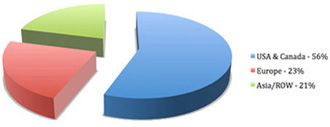Market Profile: GC-MS
Gas chromatography-mass spectrometry (GC?MS) combines a gas chromatographic front-end separation with a mass spectrometer. For the most part, the gas chromatographs and mass spectrometers used are modular in design and are relatively easily to separate. GC?MS is the most widespread tandem technique in the analytical instrumentation industry. The systems are employed in many different industries, particularly for environmental, chemical, and toxicological applications.
Gas chromatography-mass spectrometry (GC–MS) combines a gas chromatographic front-end separation with a mass spectrometer. For the most part, the gas chromatographs and mass spectrometers used are modular in design and are relatively easily to separate. GC–MS is the most widespread tandem technique in the analytical instrumentation industry. The systems are employed in many different industries, particularly for environmental, chemical, and toxicological applications.

Regional distribution of SDi's survey of GC and GC-MS users
The mass analyzers used in GC–MS include quadrupole, ion trap, and time-of-flight (TOF) analyzers. Quadrupole mass analyzers consist of four parallel rods. By simultaneously changing both the dc and rf amplitudes applied to the rods, ions of various sizes (mass-to-charge ratios [m/z]) are able to pass through the quadrupole to the detector.
Ion traps use an electric field that is generated by a sandwich geometry in which a space is bounded in three dimensions by ring and cap electrodes on each end. Ions of selected m/z range are trapped in the space bound by the electrodes, and the electric field is varied to eject ions of increasing m/z for detection. Ion traps can perform multiple MS-MS dissociations as well.
In TOF mass analyzers, which operate in a pulsed mode rather than a continuous mode, all the ions are accelerated to the same kinetic energy and are pulsed into the field-region of the flight tube. Ions with different m/z values arrive at the detector at different times. Lighter atoms with higher velocities arrive before the heavier atoms.
In a recent survey of nearly 400 GC and GC–MS users conducted by Strategic Directions International (SDi), the end users were asked to rate a variety of instrument parameters according to how important they were when selecting a GC–MS instrument. Overall, system quality and reliability, sensitivity, and post-sales service and support were the highest-rated factors by the survey participants.
The accompanying graph shows the regional distribution of respondents to the survey. Participants from USA and Canada represented the largest number of respondents, followed by Europe, and Asia/Rest of World.
The foregoing data were extracted from SDi's Tactical Sales and Marketing (TSM) report entitled GC and GC/MS: Global Insight into Market Trends and End-User Attitudes. For more information, contact Glenn Cudiamat, VP of Research Services, Strategic Directions International, Inc., 6242 Westchester Parkway, Suite 100, Los Angeles, CA 90045, tel. (310) 641-4982, fax (310) 641-8851, email: cudiamat@strategic-directions.com
Regulatory Deadlines and Supply Chain Challenges Take Center Stage in Nitrosamine Discussion
April 10th 2025During an LCGC International peer exchange, Aloka Srinivasan, Mayank Bhanti, and Amber Burch discussed the regulatory deadlines and supply chain challenges that come with nitrosamine analysis.
Top Execs from Agilent, Waters, and Bruker Take the Stage at J.P. Morgan Healthcare Conference
January 16th 2025The 43rd Annual Healthcare J.P. Morgan Healthcare Conference kicked off in San Francisco earlier this week. Here’s what top executives from Agilent, Bruker, and Waters, discussed during the event.

.png&w=3840&q=75)

.png&w=3840&q=75)



.png&w=3840&q=75)



.png&w=3840&q=75)


